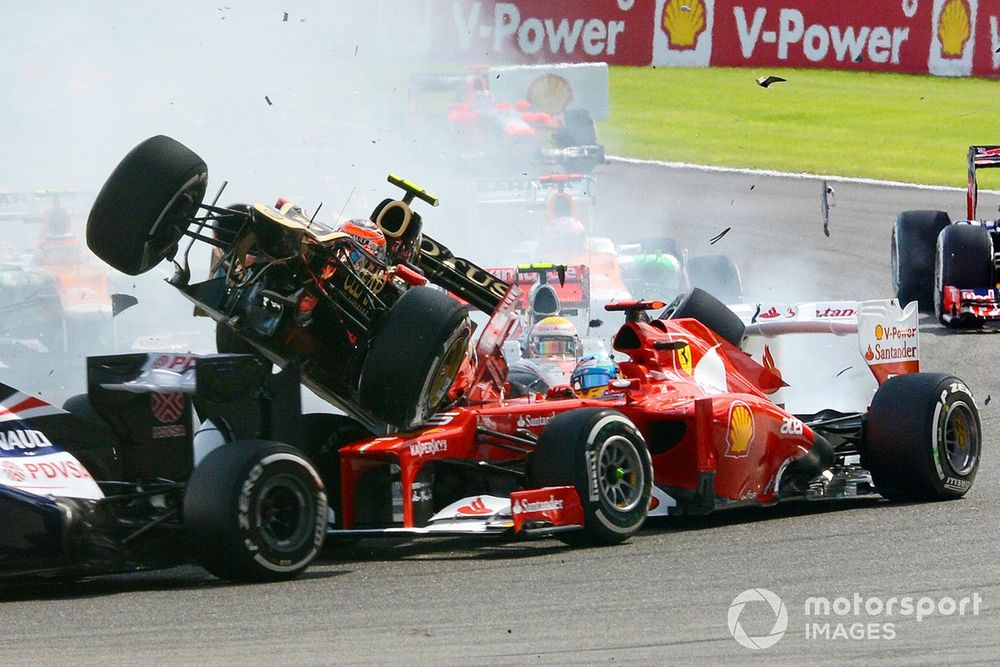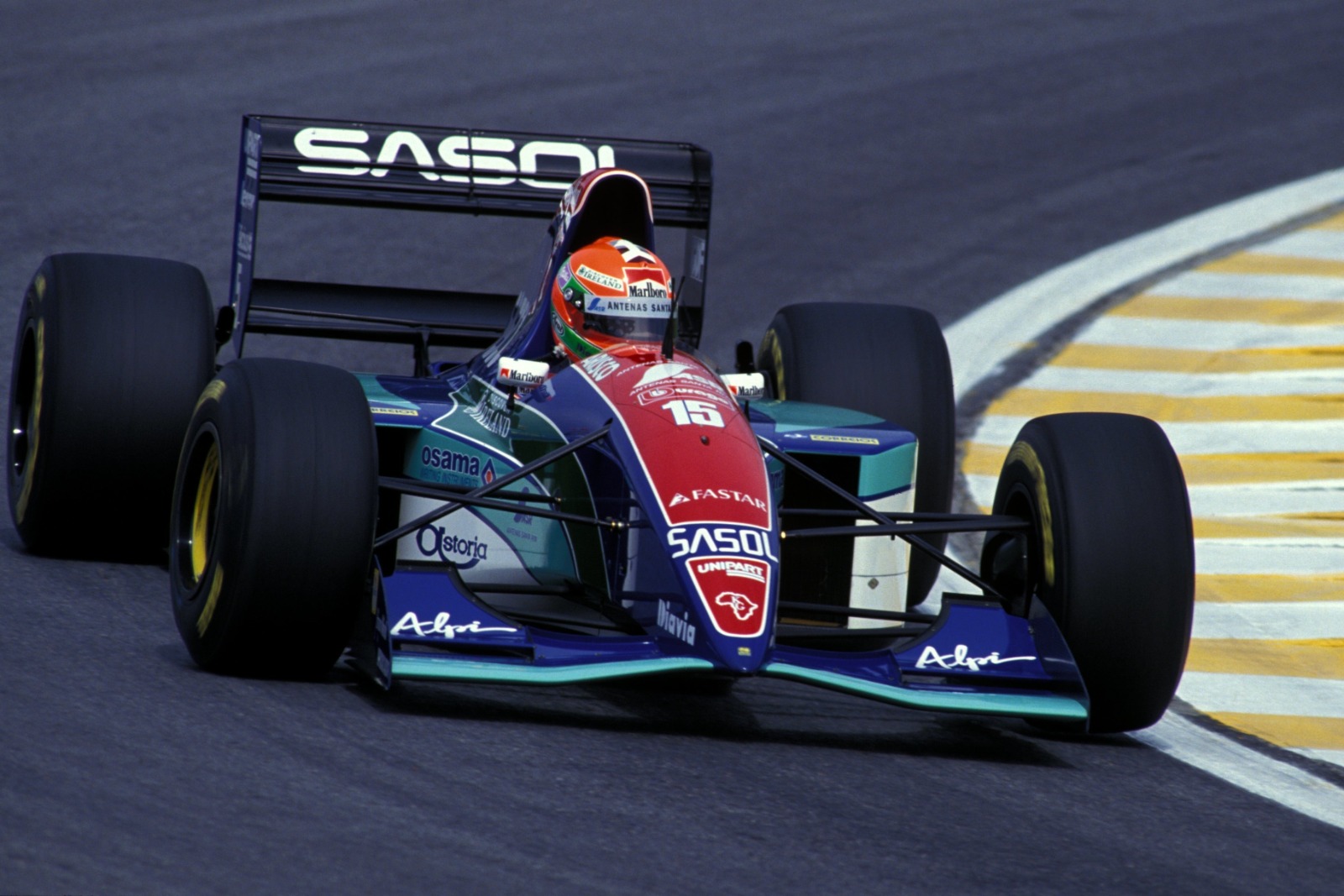Haas’ Kevin Magnussen is just two superlicence penalty points away from a full race ban after accumulating 10 points over the first six races of 2024. The Danish driver doubled his penalty points over the Miami Grand Prix weekend for several reasons, including leaving the track multiple times to gain an advantage and causing a collision with Logan Sargeant.
Magnussen initially called the sprint penalties “well deserved” for his “stupid tactics”, but ahead of the Imola GP he confirmed he will “have to” race differently and “be careful not to get a race ban”.
When questioned about whether he thought there was something wrong with the current penalty point system, Magnussen said: «The fact that I’m at risk of a race ban for driving outside of some white lines – on a piece of Tarmac – I don’t know if I feel that that is right.
«But it is the way the rules are. I accept that but I feel there is room for improvement there. Not only in terms of the [penalty] points. There are more races now than there was back when they were introduced and I feel you can end up getting a race ban effectively for a very minor thing. That’s what I feel.»
Magnussen now leads the F1 grid with the most penalty points this season and faces the risk of a full race ban. The penalty point system is in place to control driver behaviour, and any points will not expire until 12 months after they were awarded.
If a driver receives 12 penalty points on their licence they will face a race ban and will not be allowed to compete in the following grand prix. No driver has faced a race ban under the current penalty point system, which was introduced in 2014.
George Russell, the director of the Grand Prix Drivers’ Association, has since shared the positive impact of a race ban, and added that he did not think the penalty system needed changing. The Mercedes driver said: «If you look over the last 20 years I don’t know how many drivers have been given a race ban. I can only think of one there’s been in 20 years. In a football game people get red cards quite regularly.
«You can look at it saying there’d be an opportunity for a young driver to show what they are capable of if a driver is deserving of a race ban. Maybe a race ban is a bit harsh but things shouldn’t go unpunished.»
Alongside the licence points, there is a range of penalties that can be handed out, depending on the severity of the driver or team’s actions.
F1 drivers who received a race ban
Romain Grosjean — 2012 Belgian Grand Prix

Romain Grosjean, Lotus E20 is launched over the top of Fernando Alonso, Ferrari F2012
Photo by: Mark Sutton / Motorsport Images
Romain Grosjean was handed a one-race ban and fined €50,000 for causing a crash at the start of the 2012 Belgian GP. The Lotus driver had an incident-packed season with seven early-race clashes in the first 12 contests, which culminated in a multi-car crash at the start of the Spa encounter.
Grosjean moved up the inside of La Source, squeezing Lewis Hamilton tightly between himself and the pitwall and onto the grass. The pair then made contact before crashing into Fernando Alonso in the Ferrari and both the Saubers of Sergio Perez and Kamui Kobayashi, the latter having started second on the grid.
Pastor Maldonado was also caught by Grosjean during the accident, which sent the Williams spinning in front of Perez, who had completely lost his rear wing. In the chaos of the crash, Grosjean went airborne over the top of Alonso’s car before coming to a stop against the outside wall.
Kobayashi and Maldonado were the only two drivers to continue after the crash, but the Sauber driver had significant damage to his car’s side.
Grosjean accepted that the race ban was his mistake but added he had not intended to squeeze Hamilton against the wall, saying: “We know that La Source is a very tough corner. It was a bit of a crazy start as well with [Pastor] Maldonado leaving [the grid early] and the Sauber [Kobayashi] smoking a lot.
«I did a mistake and I misjudged the gap with Lewis. I was sure I was in front of him. So a small mistake made a big incident. I didn’t change my line, I went from left to right. I was not really wanting to put anyone in the wall — I’m not here to stop the race in the first corner. I’m very, very sorry and I’m glad that nobody is hurt.
«But I have to say it is a very, very hard decision to hear.»
The stewards ruled that Grosjean was responsible for the multi-car crash and awarded him a one-race ban for the following week’s Italian GP. They also noted that two of the drivers eliminated in the crash were championship contenders — Alonso (first) and Hamilton (fourth).
A statement from the officials said: “The stewards regard this incident as an extremely serious breach of the regulations which had the potential to cause injury to others.”
It also noted the team had not contested the verdict, saying: «The stewards note the team conceded the action of the driver was an extremely serious mistake and an error of judgement. Neither the team nor the driver made any submission in mitigation of penalty.»
Jerome d’Ambrosio climbed behind the wheel of the Lotus for the 2012 Italian GP, following Grosjean’s ban.
Felipe Massa — 2002 Italian Grand Prix

Massa wasn’t banned for Monza clash with de la Rosa, but Sauber replaced him to avoid serving a penalty
Photo by: Motorsport Images
Although technically not an official race ban, Felipe Massa was forced to miss the 2002 United States GP due to technicalities in the grid place penalty regulations. The Sauber driver was handed a 10-place grid penalty during the Italian GP for causing a collision with Pedro de la Rosa’s Jaguar.
Both drivers were forced to retire from the race before being called to the stewards to investigate the crash. They found the Brazilian responsible and handed him the 10-place grid penalty — the first of its kind to be awarded to a driver.
In 2002, the regulations stated that the penalty would be in place for ‘the next’ race and not the ‘driver’s next race’, which resulted in Sauber deciding to avoid serving the penalty by removing Massa from the US GP.
Heinz-Harald Frentzen, who had previously driven for the team between 1994-1996, was set to return to the team in 2003 but was brought in for the 2002 US GP in a bid to help the team’s constructors’ championship fight with Jaguar.
Jacques Villeneuve — 1997 Japanese Grand Prix

Villeneuve raced in Japan but was later disqualified
Photo by: Williams F1
Jacques Villeneuve’s race ban is a unique situation, after the Williams driver was still allowed to participate in the race due to the team appealing the decision from the stewards. The Canadian driver was leading the championship by nine points from Michael Schumacher at the time, with two races remaining.
Villeneuve had qualified on pole for the 1997 Japanese GP but, ahead of the race, he was disqualified from participating by the stewards. They ruled he had failed to slow his Williams at the Spoon Curve during Saturday’s practice session when passing the stranded Tyrrell of Jos Verstappen.
He was one of five drivers that had failed to slow for the yellow flags, with Schumacher, Rubens Barrichello, Johnny Herbert and Ukyo Katayama all receiving one-race bans, which were suspended until the end of the season. Villeneuve had already previously committed the same offence on three other occasions and, with a suspended ban already looming over the Williams driver, he was given an immediate ban for the next race (which was the Japanese GP as it had not taken place).
Williams lodged an appeal against the stewards’ decision to ban Villeneuve from the race and, with no time to assemble a hearing, he was allowed to take part from his pole position. During the race he was able to finish fifth, which awarded him two points — however, Williams decided to withdraw its appeal so the race ban was upheld and he was disqualified from the result.
Michael Schumacher — 1994 Italian and Portuguese grands prix

Schumacher was later banned for failing to serve penalty for overtaking on the green-flag lap
Photo by: LAT Photographic
Michael Schumacher was awarded a two-race ban in 1994, missing both the Italian and Portuguese grands prix. The German driver received a penalty for overtaking Damon Hill on the formation lap of the British GP and then repeated the violation following an aborted start.
Under the 1994 regulations, the first offence should have resulted in Schumacher being ordered to start from the back of the grid but the British GP officials were unaware of these rules. On lap 13 he was given a penalty but there was initial confusion as it was announced he was penalised five seconds and Benetton did not call him in to pit as there was no mention it was a stop/go penalty.
Again under 1994 regulations, any time penalty given before the final 12 laps of the race must have been served in the pitlane. After seven laps had passed, Schumacher was shown the black flag, which indicated that he must return to the pits. He ignored the black flag, claiming he could only see his number being displayed but not the flag itself.
Benetton decided to appeal the verdict, which meant a hearing did not take place until after the Belgian GP, which Schumacher was also disqualified from. His car was found to have “illegal wear” on the skid block, which Benetton protested was due to him spinning over a kerb.
However, this was rejected by the FIA as it was claimed there was a pattern of wear and damage to the block. Following the race, Schumacher’s two-race ban was upheld by the FIA and he was forced to miss the Italian and Portuguese events.
Mika Hakkinen — 1994 British Grand Prix

Hakkinen (whose McLaren is spinning here) was banned for his part in this Hockenheim pile-up
Photo by: Motorsport Images
Mika Hakkinen was given a one-race ban, suspended for three races, alongside Rubens Barrichello for a last-lap collision at the 1994 British GP. However, his ban was triggered at the start of the following race — the German GP — when the McLaren driver caused a multiple-car collision at the first corner.
Hakkinen made contact with David Coulthard’s Williams and spun across the field, taking out several cars in the process. There were 11 retirements during the first lap of the race with 10 drivers being involved in crashes before the first corner.
The Finnish driver accepted the penalty and McLaren did not appeal the FIA’s decision.
Eddie Irvine — 1994 Pacific, San Marino & Monaco Grands Prix

Irvine’s Brazilian GP actions earned him a three-race ban after initial one-race penalty was appealed
Photo by: Motorsport Images
Eddie Irvine initially picked up a one-race ban at the Brazilian Grand Prix for causing a four-car collision on lap 35. The Irish driver suddenly swerved to avoid Martin Brundle’s McLaren, which had suffered engine failure, and thereby forced Jos Verstappen onto the grass.
The Benetton driver lost control of his car and flew over the top of Brundle, damaging the Briton’s helmet. The Ligier of Eric Bernard was also caught up in the crash as he attempted to take avoiding action.
Irvine was given a one-race ban and fined $10,000. This was appealed by Jordan but was rejected, and he was given an extended three-race ban. The FIA hoped the decision would serve as a warning to other teams to consider appeals against the stewards’s rulings.
Irvine said the four cars had come together as a result of the stopped McLaren, as well as claiming that his battle with Ayrton Senna the following year in Japan had influenced the officials.
His seat was given to Aguri Suzuki for the Pacific GP, before Andrea de Cesaris climbed into the Jordan for both the San Marino and Monaco races.
Nigel Mansell — 1989 Portuguese Grand Prix

Mansell was already in hot water for pitlane antics before colliding with Senna
Photo by: Motorsport Images
Nigel Mansell was given a one-race ban after ignoring a black flag for reversing in the pitlane at the 1989 Portuguese GP. The British driver had locked up coming into the pits and chose to drive around his mechanics instead of driving through them.
Mansell claimed he had not seen the black flag or a Ferrari pitboard, as well as stating he was not able to hear radio messages over the volume of his engine during a battle with Ayrton Senna. Both drivers collided, taking them both out of the race. The FIA took the view that Mansell had been driving under a black flag and had taken out a championship contender, and awarded him a one-race ban.
Ferrari did not replace Mansell with another driver for the Spanish GP to race alongside Gerhard Berger.
Riccardo Patrese — 1978 Italian Grand Prix

Patrese was banned for his part in tragic startline pile-up
Photo by: Motorsport Images
Riccardo Patrese was known for his aggressive racing and had angered a number of drivers at the wheel of his Arrows during the season. At the start of the 1978 Italian GP, Patrese overtook James Hunt, which resulted in the McLaren veering into the right-rear wheel of Ronnie Peterson’s Lotus.
Seven other drivers were caught up in the incident and it resulted in the Lotus flying into the barriers and catching fire. Peterson was trapped inside his car but was freed by Hunt, Clay Regazzoni and Patrick Depallier before he was more badly burnt. The Swedish driver was conscious but had suffered 27 fractures to his legs and feet. Although the injuries were not life-threatening, he died the following day from a fat embolism.
At the next race, Patrese was informed by Bernie Ecclestone that several drivers — including past or future champions Hunt, Mario Andretti, Niki Lauda, Emerson Fittipaldi and Jody Scheckter — would withdraw from the race if he was not banned. Organisers agreed to ban Patrese and, although Arrows sought the opinion of a judge, the team decided to withdraw the Italian from the race.








